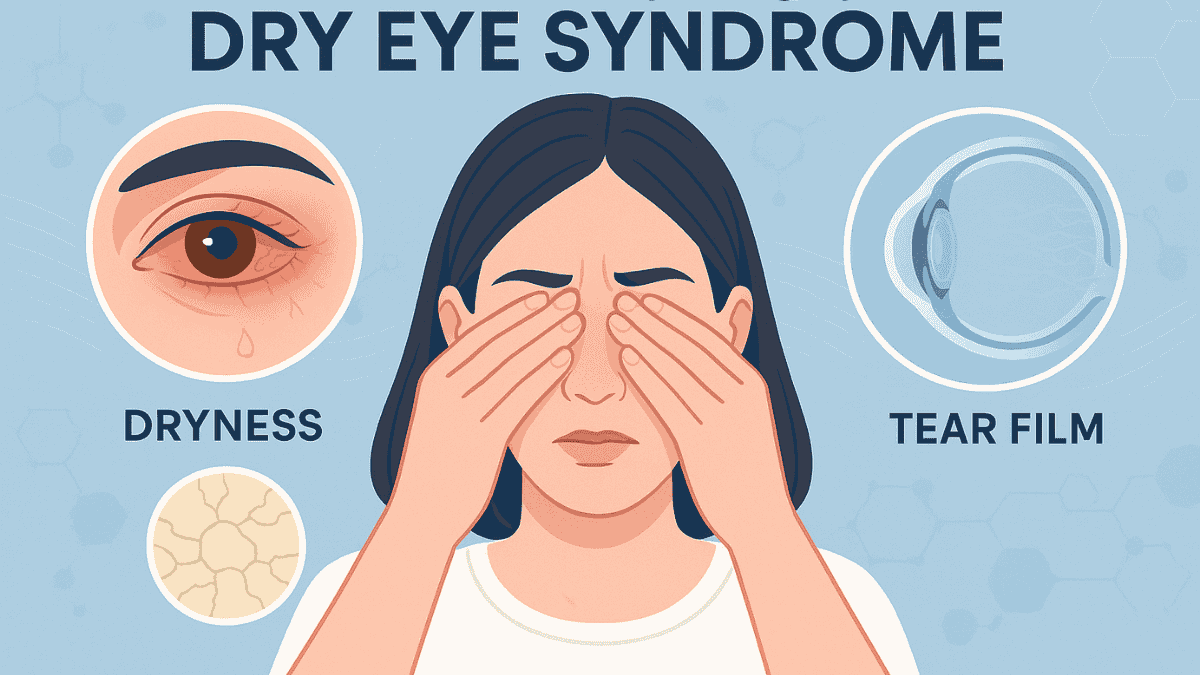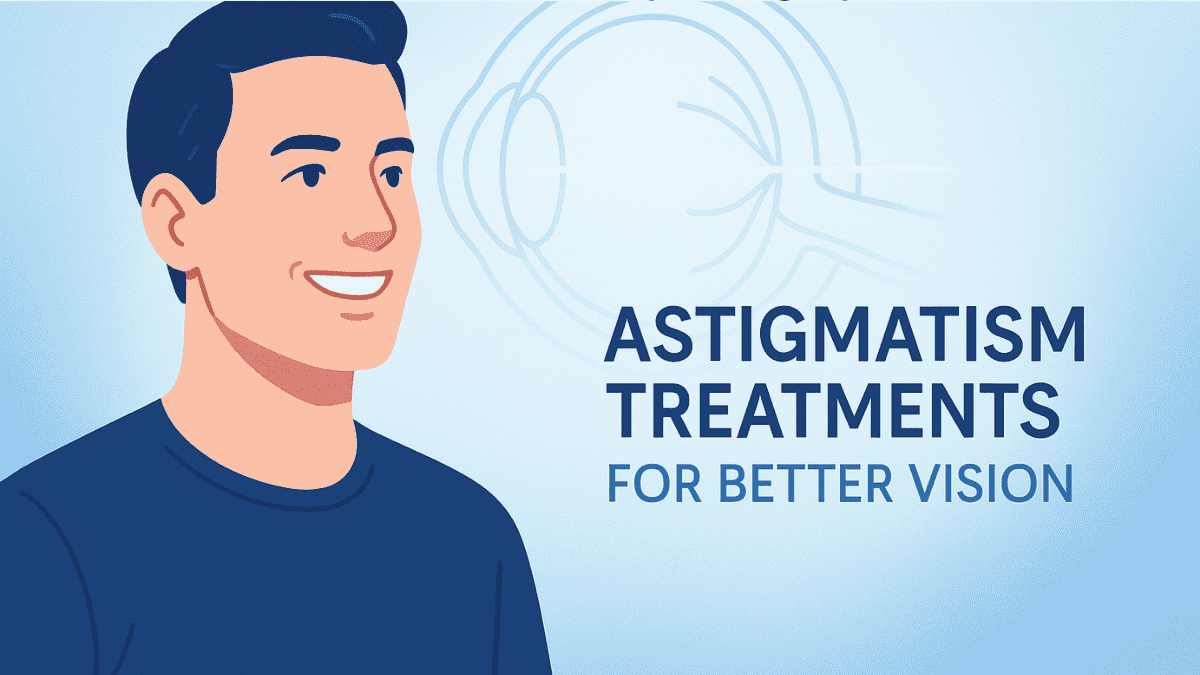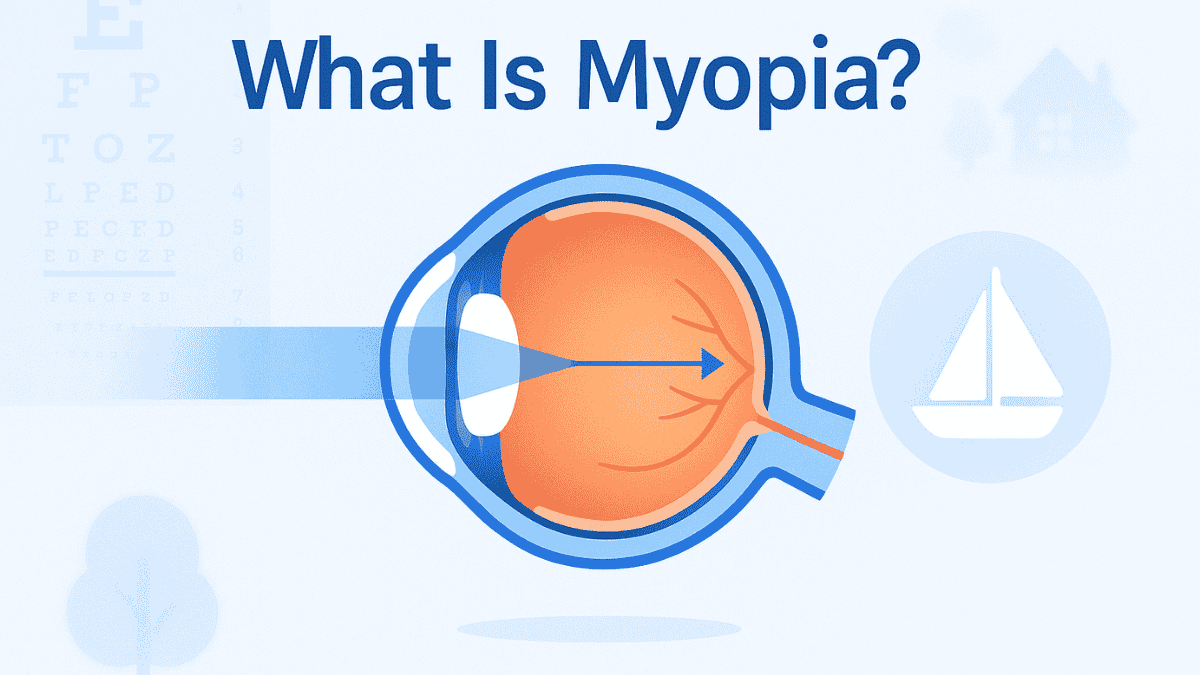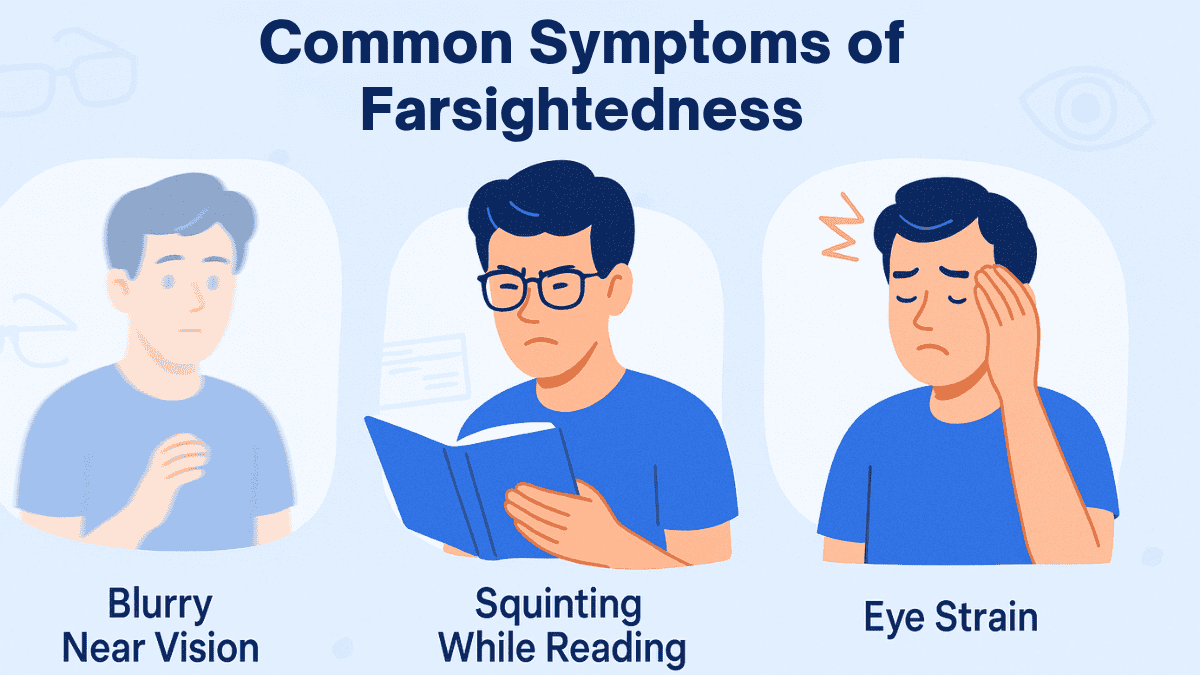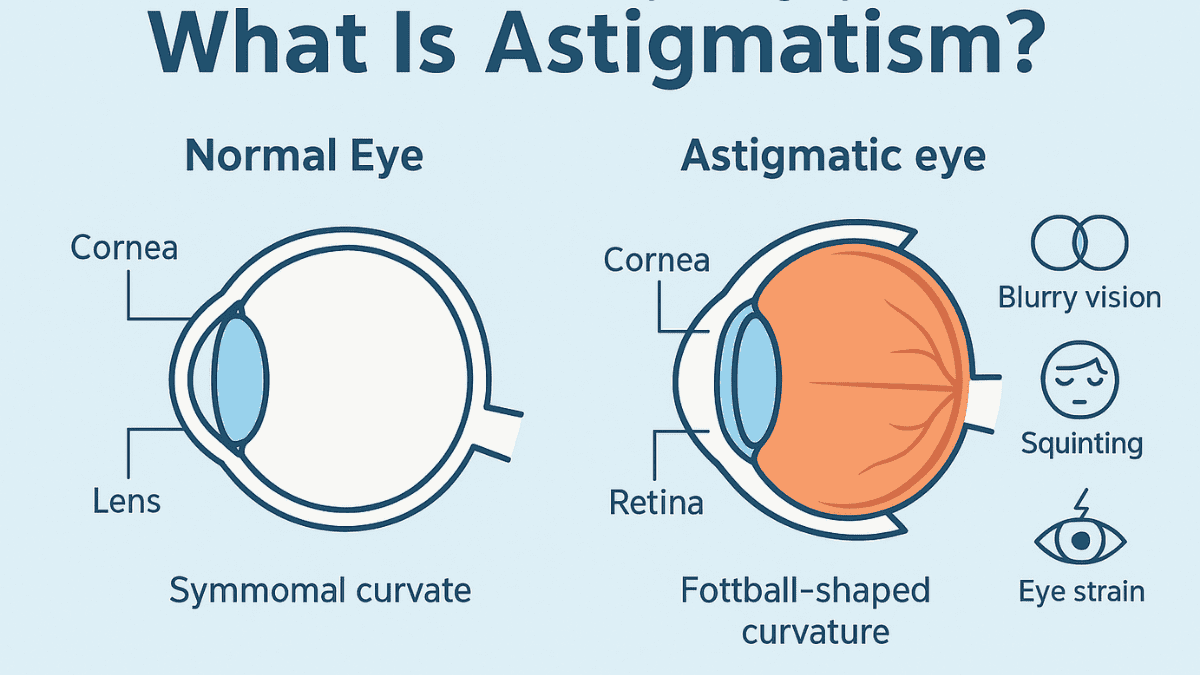
Astigmatism is a common eye condition that affects many people. It’s often misunderstood, so let’s clear things up. What is astigmatism? It is a type of refractive error that causes blurry or distorted vision, affecting how your eye focuses light.
If you’ve been squinting a lot, experiencing eye strain, or getting headaches, you might have astigmatism. This eye condition happens when your eye’s cornea or lens has an irregular eye shape, more like a football than a sphere. This irregularity prevents light rays from focusing properly on a single point on the retina, leading to fuzzy or blurred vision occur.
Astigmatism can occur in both children and adults and often accompanies other vision problems like nearsightedness (myopia) or farsightedness (hyperopia). Understanding this common eye health issue is the first step toward achieving clear vision. Many people have questions about how astigmatism happen and its implications for their sight.
Table of Contents
What Causes Astigmatism?
Astigmatism often develops during childhood, but it is also possible for adults to develop this eye condition later in life. The precise reason astigmatism occur is not always fully understood. Many individuals are born with an irregularly shaped cornea or lens, making genetics a significant factor in its development.
If your parents have astigmatism, your astigmatism risk might be higher. Additionally, an eye injury, trauma to the eye, or complications from certain types of eye surgery can sometimes lead to the development of astigmatism. Conditions like keratoconus, where the cornea progressively thins and bulges outward into a cone shape, are also known causes of, typically irregular astigmatism.
It is a common misconception that habits such as reading in dim light or sitting too close to a television screen cause astigmatism; these activities might cause temporary eye strain but do not alter the anatomy eye or lead to this specific refractive error. Understanding the true causes helps in managing expectations and seeking appropriate eye care. The way your eye refract light is central to how vision occur, and astigmatism disrupts this process.
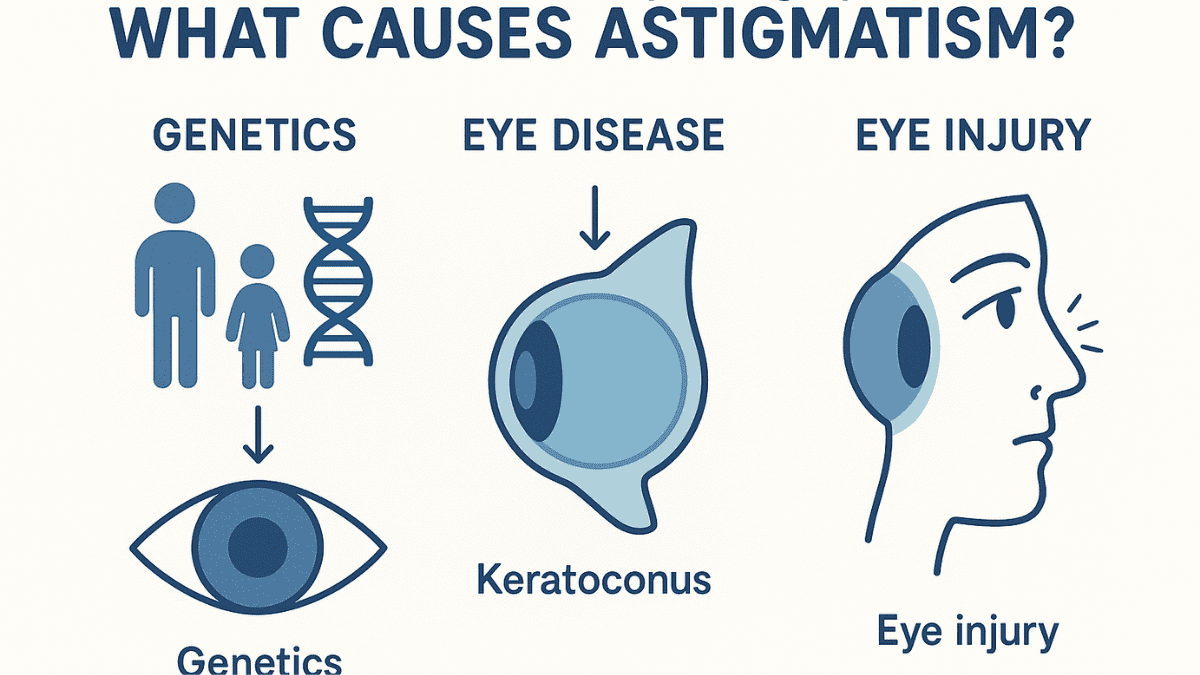
Types of Astigmatism
There are primarily two main types of astigmatism, categorized by which part of the eye has an irregular shape: corneal astigmatism and lenticular astigmatism. Corneal astigmatism is the more prevalent type. It arises when the cornea, the clear front surface of your eye, has an imperfect curvature.
Lenticular astigmatism, on the other hand, occurs when the lens inside your eye, situated behind the iris and pupil, is misshapen. While less common than corneal astigmatism, it similarly affects how light focus onto the retina, resulting in distorted vision. Both types can impact your ability to see distant objects clearly.
These types can be further classified as regular or irregular astigmatism. Regular astigmatism means the cornea is curved more in one direction than the other, like a football, and is the most common form; it can usually be corrected with eyeglasses or standard toric contact lenses. Irregular astigmatism, often resulting from an eye injury, surgery, or conditions like keratoconus, involves a cornea that is not symmetrically curved and can be more challenging to correct, sometimes requiring specialized contact lenses or other treatments.
Here’s a simple comparison:
| Feature | Corneal Astigmatism | Lenticular Astigmatism |
|---|---|---|
| Affected Part | Cornea (front surface of the eye) | Lens (inside the eye, behind the iris) |
| Prevalence | More common | Less common |
| Cause of Blurry Vision | Irregular curvature of the cornea | Irregular curvature of the lens |
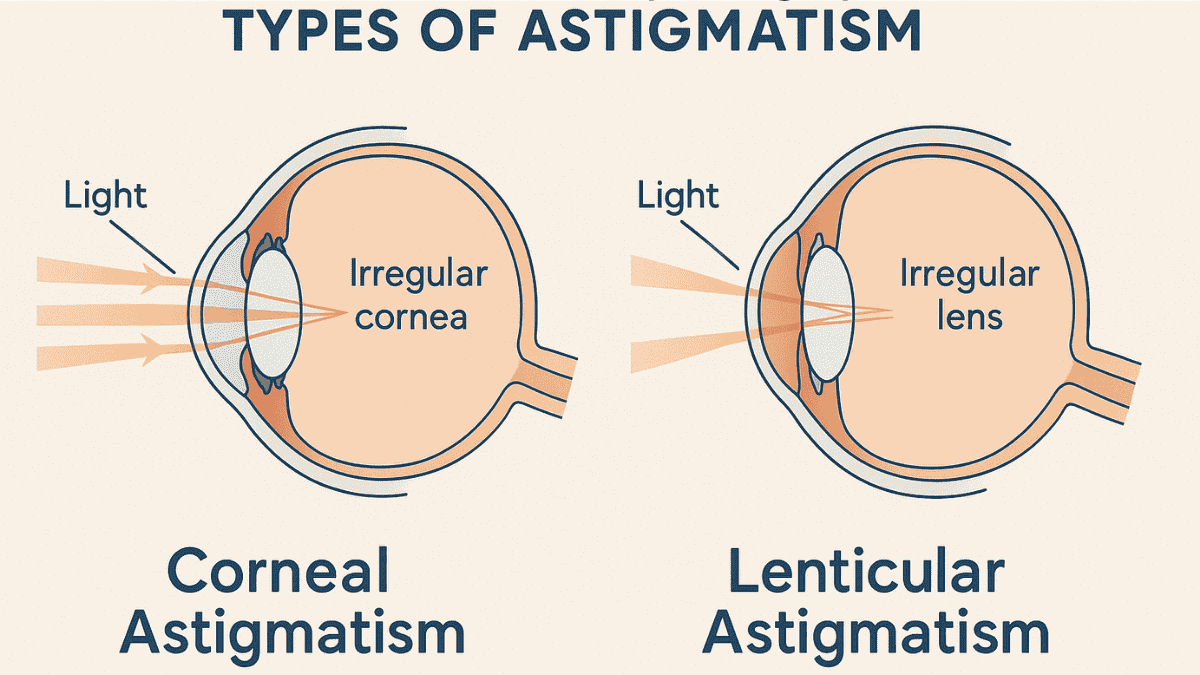
Symptoms of Astigmatism
Recognizing the symptoms of astigmatism is important for seeking timely eye care. If you have astigmatism, you might notice various indicators. Here are some common signs that suggest you may have this refractive error:
- Blurry vision or distorted vision at all distances, affecting both near and distant objects.
- A persistent need to squint to see clearly, whether looking at something up close or far away.
- General eye strain or discomfort, particularly after periods of visual concentration.
- Headaches, which can be more frequent after activities like reading, using a computer, or focusing for extended periods.
- Difficulty with night vision, sometimes perceiving halos or starbursts around lights.
- Tilting your head to try to improve eye focus.
These symptoms can vary in intensity depending on the degree of astigmatism. If you experience any of these issues, scheduling an eye exam with an eye doctor is a good step. These professionals can accurately diagnose astigmatism and other vision problems, distinguishing it from other eye conditions such as macular degeneration or issues requiring cataract surgery.
For children, especially during their school years, undiagnosed astigmatism can affect learning and classroom participation. Paying attention to their visual behaviors is important for early detection. This is one of the many frequently asked questions parents have about their child’s eye health.
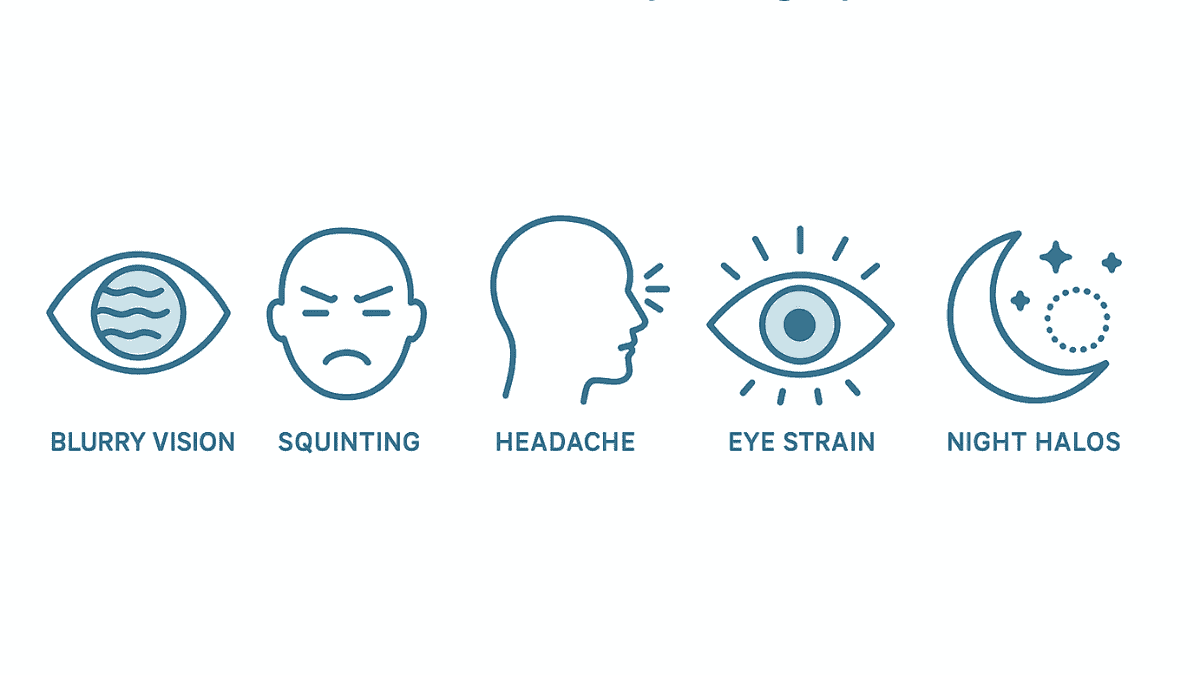
Diagnosing Astigmatism
An eye doctor, such as an optometrist or ophthalmologist, diagnoses astigmatism during a comprehensive eye exam. Several tests are employed to assess your vision and the specific characteristics of your eyes. A common starting point is a visual acuity test, where you read letters from a chart (like a Snellen chart) to determine the clarity of your vision at various distances.
To measure how your eye focuses light and to determine the power of lenses needed for vision correction, your eye doctor may use a device called a phoropter. This instrument has many lenses you look through while the doctor asks which ones provide the clearest vision. An autorefractor is another instrument that provides an initial objective measurement of the refractive error by shining a light into your eye and measuring how it changes as it bounces off the back of the eye.
A keratometer is specifically used to measure the curvature of your cornea, identifying any irregularities indicative of corneal astigmatism. For a more detailed assessment of the cornea’s surface, a corneal topographer can be used. This advanced imaging technique creates a 3D map of the cornea, which is particularly useful for fitting contact lenses or planning refractive surgery. These eye exams are generally painless, quick, and crucial for determining if you have astigmatism and its severity, leading to effective treatment and better eye health.
Information from reputable sources like the National Eye Institute or a major medical center can provide more background on these diagnostic eye procedures. When you request appointment, be sure to describe any vision problems you’re experiencing.
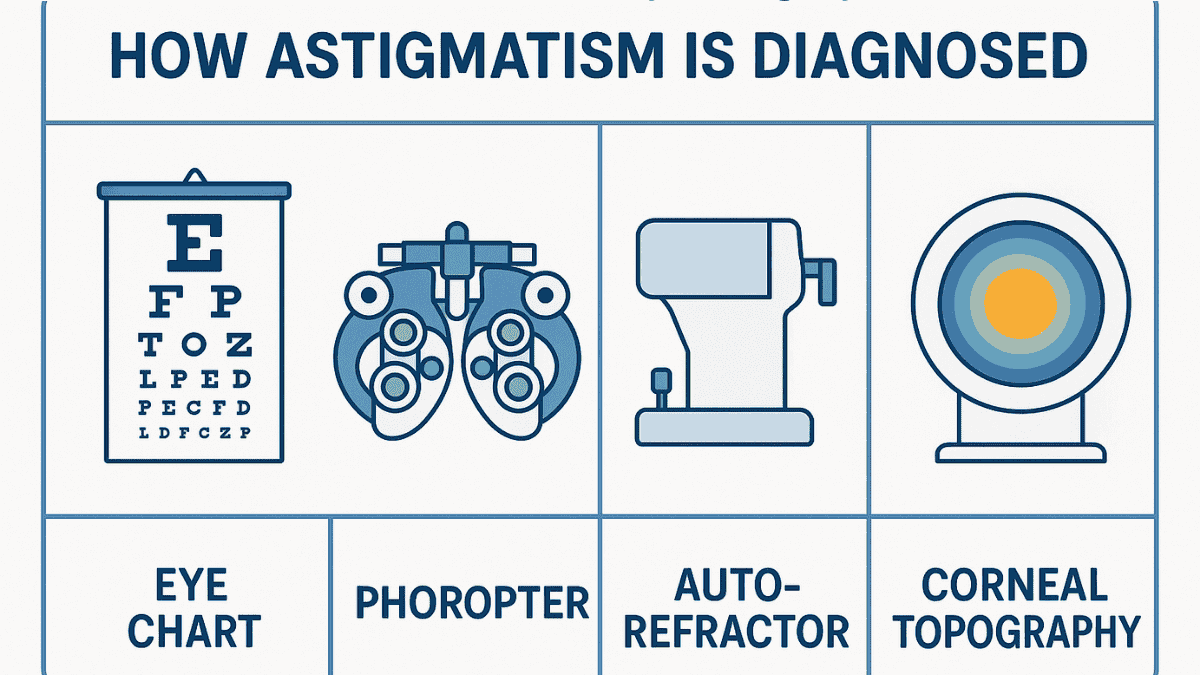
Treatment Options for Astigmatism
Fortunately, astigmatism is a highly treatable eye condition, and several vision correction options are available to help you achieve clear sight. The most suitable treatment depends on the severity of the astigmatism, your lifestyle, and personal preferences. Consulting with medical professionals is vital to determine the best course of action.
Eyeglasses
Prescription eyeglasses are the most common and simplest way to correct astigmatism. The lenses in these glasses are cylindrical, specially shaped with an additional power to compensate for the eye’s irregular curve, allowing light to refract properly onto the retina. These lenses correct the astigmatism and can also incorporate correction for other refractive errors like nearsightedness or farsightedness if present.
Your eye doctor will provide a prescription that includes values for sphere (for nearsightedness or farsightedness), cylinder (for astigmatism), and axis (the orientation of the astigmatism). Understanding your prescription can be helpful. Many find glasses a straightforward solution to their blurred vision needs.
Contact Lenses
For individuals who prefer not to wear glasses, contact lenses are an excellent alternative. Special toric contact lens designs are available specifically for astigmatism. These lenses have different powers in different meridians and are designed to stay stable on the eye, providing clear vision despite the irregular eye shape.
Rigid gas-permeable (RGP) contact lenses are another effective option, particularly for higher amounts or irregular types of astigmatism. These lenses maintain their shape on the eye, effectively creating a new, smooth refractive surface over the cornea. Both soft toric and RGP lenses require a proper fitting by an eye care professional to ensure comfort and optimal vision correction. It’s important to follow guidelines for contact lens care to avoid complications like dry eye or infections.
Orthokeratology
Orthokeratology, or Ortho-K, is a non-surgical treatment that involves wearing specially designed rigid gas-permeable contact lenses overnight. These lenses gently reshape the cornea while you sleep. In the morning, the lenses are removed, and you can typically see clearly throughout the day without needing glasses or contact lenses.
The effect of Ortho-K is temporary, so the lenses must be worn regularly at night to maintain the corneal reshaping and clear vision. This option is suitable for certain individuals with mild to moderate astigmatism and can be a good choice for those who are active in sports or prefer not to wear corrective lenses during the day. Your eye doctor can advise if Ortho-K is appropriate for your specific eye condition. Ongoing clinical trials continue to refine this technology.
Related Article
Safe Alternatives to LASIK: PRK, LASEK, and Ortho-K ExplainedLaser Surgery and Other Refractive Surgery Options
For a more permanent solution to astigmatism, various types of refractive surgery are available. Procedures like LASIK (laser-assisted in situ keratomileusis) eye surgery can reshape the cornea using a laser, thereby correcting the refractive error that causes astigmatism. Other laser surgery options include PRK (photorefractive keratectomy) and SMILE (small incision lenticule extraction).
These eye surgery procedures aim to allow individuals to see clearly without glasses or contact lenses. However, they are not suitable for everyone; factors such as corneal thickness, overall eye health, and the stability of your prescription are considered. An eye surgeon will conduct a thorough evaluation to determine candidacy. Potential risks and benefits should be discussed in detail, and information from organizations like the American Academy of Ophthalmology can be helpful. Some institutions may offer financial assistance or clear price transparency for these eye procedures.
In some cases, especially if astigmatism coexists with cataracts, lens surgery involving the implantation of a toric intraocular lens (IOL) can correct astigmatism during cataract surgery. This specialized intraocular lens can significantly improve vision by addressing both the cataract and the astigmatism in one procedure.
Related Article
Eye Laser Surgery for Astigmatism: Options and Considerations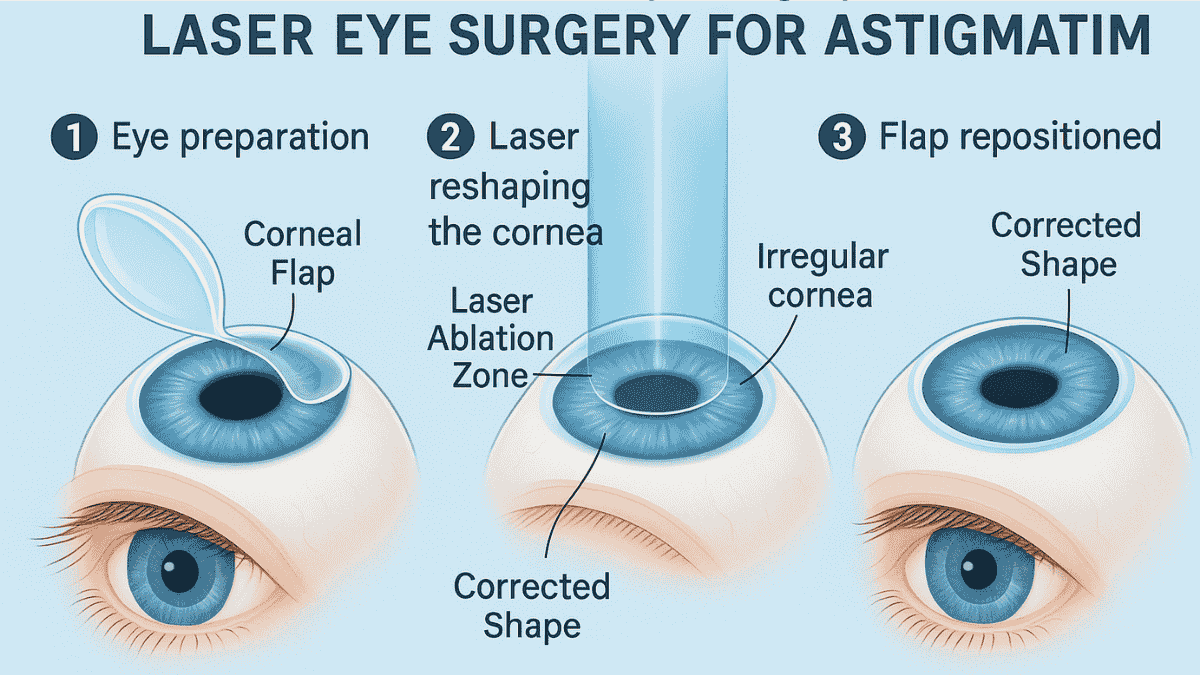
Living with Astigmatism
Living with astigmatism does not have to limit your daily activities or quality of life. With appropriate vision correction, most individuals can see clearly and comfortably. Regular eye check-ups with your eye doctor are important to monitor your eye health, check for any changes in your astigmatism or other refractive errors, and update your prescription as needed.
Some people might worry that their astigmatism will worsen over time. While prescriptions can change, particularly during childhood and young adulthood, astigmatism doesn’t invariably progress. Many people find their prescription remains relatively stable for many years. If changes do occur, adjusting your glasses or contact lens prescription can typically maintain clear vision.
If you wear contact lenses for astigmatism, practicing good hygiene is vital to prevent eye infections or irritation. Always wash your hands thoroughly before handling your lenses, and follow your eye doctor’s instructions meticulously for cleaning, disinfecting, and storing them. Pay attention to replacement schedules and avoid over-wearing your lenses, which can increase the risk of complications such as dry eye. Following these eye care practices will support long-term eye health.
Related Article
Managing Dry Eye Syndrome: Causes and TreatmentsMaking small adjustments to your environment can also help manage symptoms like eye strain. Proper lighting when reading or working, taking regular breaks from screens, and ensuring your computer monitor is positioned correctly can all contribute to greater visual comfort. Understanding your eye condition and working with your eye care provider will help you manage it effectively.
Astigmatism in Children
Astigmatism is common in children; in fact, many infants are born with some degree of it, which may resolve on its own as they grow. For others, astigmatism persists and requires vision correction. Early detection and management of astigmatism in children are crucial, as uncorrected vision problems can impact their learning, development, and performance during their school years.
Comprehensive eye exams are essential for children, even if they don’t complain about vision problems. A pediatric eye specialist or an optometrist experienced with children can detect astigmatism and other eye conditions. The American Optometric Association recommends regular eye exams for children, starting in infancy. Signs that a child might have a vision problem, including astigmatism, include:
- Frequent squinting or tilting their head to see better.
- Often rubbing their eyes.
- Sitting unusually close to the television or holding books and tablets very close to their face.
- Complaining of headaches or tired eyes.
- Avoiding activities that require good near or distant vision, such as reading or sports.
- Appearing clumsy or having difficulty with tasks requiring hand-eye coordination.
If you notice any of these signs, it’s important to schedule an eye exam for your child. Early treatment, typically with eyeglasses, can correct the blurred vision from astigmatism and help prevent potential complications like amblyopia (lazy eye). Amblyopia can develop if one eye has significantly more uncorrected astigmatism than the other, leading the brain to favor the clearer eye. Resources from a well-known eye institute or pediatric eye centers can offer further guidance.
Related Article
Laser Eye Surgery Age Limits: What Parents Should KnowMyths about Astigmatism
Several misconceptions about astigmatism can cause unnecessary concern. It’s helpful to separate fact from fiction to better understand this common eye condition. Addressing these myths can clarify what astigmatism is and how it’s managed.
- Myth: Astigmatism is a rare eye disease.
Fact: Astigmatism is not an eye disease but a common refractive error related to the eye shape. It is very prevalent. - Myth: You cannot wear contact lenses if you have astigmatism.
Fact: There are specially designed contact lenses, known as toric lenses, made specifically to correct astigmatism. - Myth: Reading in dim light or sitting too close to the TV causes astigmatism.
Fact: While these habits can cause eye strain, they do not cause astigmatism or change the physical structure of your eye. - Myth: Astigmatism always gets worse over time.
Fact: Astigmatism can change, especially during childhood and adolescence, but it does not necessarily worsen progressively throughout life for everyone. Many prescriptions stabilize. - Myth: Astigmatism can be cured with eye exercises.
Fact: Eye exercises cannot change the shape of the cornea or lens, which is the underlying cause of astigmatism. Vision correction methods like glasses, contacts, or refractive surgery are effective treatments.
Understanding these facts can help you feel more confident in managing your eye health or your child’s. If you have more frequently asked questions, your eye doctor is the best source for answers based on medically reviewed information. Information from a reputable medical center or the National Eye Institute can also be very informative.
When to See a Doctor
Regular eye exams are fundamental for maintaining good eye health and detecting vision problems early, including refractive errors like astigmatism. Everyone should have periodic comprehensive eye exams, even if they don’t notice any vision issues. However, certain signs and symptoms warrant a more immediate visit to an eye doctor or an eye care professional.
You should schedule an appointment if you experience:
- Sudden changes in your vision, such as a sudden onset of blurred vision, floaters, or flashes of light.
- Frequent or unexplained headaches, particularly if they seem linked to visual tasks.
- Increasing difficulty seeing clearly at night or in low light conditions.
- Persistent squinting or eye strain to see objects clearly, whether near or far.
- Any eye pain, significant discomfort, redness, or discharge.
- A suspected eye injury, no matter how minor it seems.
Do not ignore these symptoms. Early detection and treatment of eye conditions can prevent them from worsening and potentially leading to more serious vision problems. An eye doctor can determine if your symptoms are related to astigmatism, another refractive error, dry eye, or a more serious eye disease. Organizations like the American Optometric Association provide guidelines on eye exam frequency. Many clinics allow you to request an appointment online or by phone, and some provide information on financial assistance or price transparency for services. For concerns regarding privacy practices or to find a site map, clinic astigmatism information, or a privacy policy notice, check the provider’s official website.
Conclusion
So, what is astigmatism after all? It’s a common vision problem, a type of refractive error, resulting from an imperfectly curved cornea or lens, which causes blurred or distorted sight. While the term might sound concerning, it is not an eye disease and generally does not signal poor eye health on its own; it is simply a variation in eye shape that affects how light rays focus inside the eye.
With a proper diagnosis from an eye doctor through comprehensive eye exams, and the right vision correction—be it eyeglasses, contact lenses, or even refractive surgery like LASIK eye surgery—individuals with astigmatism can experience clear and comfortable vision. Astigmatism does not have to hinder your daily life or enjoyment of activities. Understanding this condition, its causes, symptoms, and treatments empowers you to take proactive steps for your eye care.
Remember, consistent check-ups with your eye care professional are crucial for maintaining optimal vision and overall eye health throughout your life. Whether you have astigmatism, are at risk for other eye conditions, or simply want to preserve your sight, prioritizing your eyes is an investment in your well-being. Your vision is a precious sense, deserving of good care and attention; many resources, from the Mayo Clinic to the National Eye Institute, provide valuable medical education. All rights reserved to those institutions for their contributions to eye health knowledge.
Related Article
LASIK Eye Surgery: What You Need to KnowFrequently Asked Questions About Astigmatism
Astigmatism can be treated with glasses, contact lenses, or refractive surgery such as LASIK or PRK.
Yes, LASIK surgery can permanently reshape the cornea to correct astigmatism in many cases.
Yes, PRK is a suitable alternative for patients who are not ideal candidates for LASIK.
Yes, toric lenses are specifically designed to correct astigmatism and are commonly used.
Yes, non-surgical treatments include prescription glasses and toric contact lenses.
Yes, SMILE is FDA-approved to treat certain degrees of astigmatism and offers a flapless alternative.
Glasses use cylindrical lenses to correct the uneven curvature of the cornea or lens.
In some cases, mild regression can occur, but it is often correctable with enhancement surgery.
Patients must generally be over 18 with stable vision for at least one year before surgery.
As with any surgery, there are risks, including dry eye, glare, and undercorrection.
An excimer laser is commonly used in LASIK and PRK to reshape the cornea.
Refractive surgery is not recommended for children; glasses or contacts are preferred.
Most patients recover functional vision within a few days to a week, depending on the procedure.
Yes, toric intraocular lenses can be implanted during cataract surgery to correct astigmatism.
RGP lenses provide sharp vision by maintaining their shape on the eye, correcting corneal irregularities.
LRI is a minor surgical procedure to flatten steep corneal meridians and reduce astigmatism.
Some multifocal contacts also correct astigmatism, but toric designs are generally more effective.
Yes, phakic intraocular lenses can be used to correct astigmatism, especially in high prescriptions.
Ortho-K lenses can temporarily reshape the cornea overnight and reduce mild to moderate astigmatism.
Results are typically permanent, but age-related changes may affect vision over time.
No scientific evidence supports eye exercises as a treatment for astigmatism.
Yes, LASIK can correct both conditions simultaneously if you’re a suitable candidate.
Yes, enhancement procedures are commonly used to fine-tune vision after initial surgery.
It’s a personalized LASIK approach using corneal mapping for more accurate treatment.
Most patients resume normal activities within 1–2 days post-LASIK or PRK.
Generally, refractive surgery is not covered as it’s considered elective.
SMILE is approved for moderate astigmatism; severe cases may need other options.
In such cases, corneal cross-linking or specialty contact lenses are preferred.
Some corneal inlays or ring segments can improve vision in irregular astigmatism.
Both are effective; LASIK offers faster recovery, while PRK may be better for thin corneas.
Sources
MayoClinic: Astigmatism

